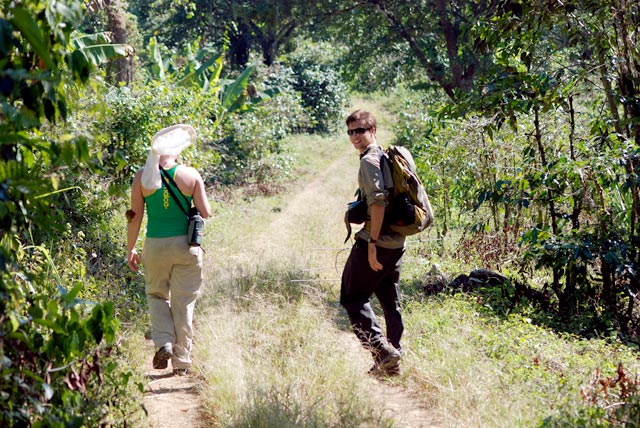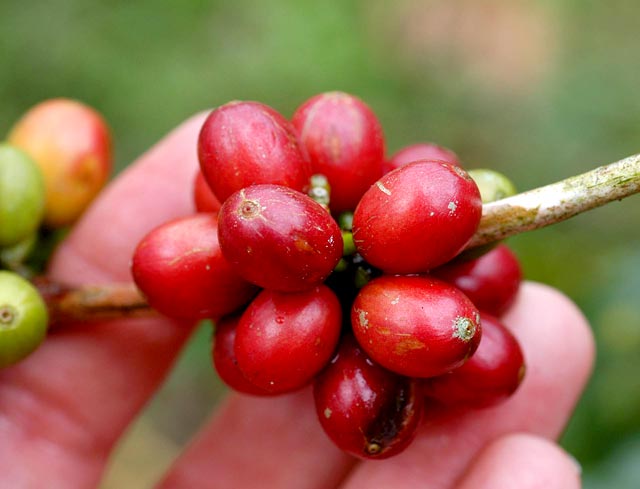
Professor Matt Johnson, an ornithologist, and Professor Michael Mesler, a pollination biology expert, traveled with a handful of students to Jamaica in December 2008 to conduct research on coffee farms. Their three-year study, funded by the National Science Foundation, is examining the behavior and benefits of birds and bees on the farms. Based on previous research in other countries like Costa Rica, Johnson and Mesler suspect that the presence of birds and bees can significantly increase yields for Jamaican coffee farmers.
“The basic purpose of our research is to understand how the land on and surrounding the coffee farms is important for wildlife,” Johnson says. “We’re seeing that shade-grown coffee provides better habitat for birds and bees than coffee grown in the open sun.”
Currently, many Jamaican farmers grow coffee in the open sun with the use of pesticides. This approach means that trees are cleared from coffee farms, eliminating habitat for birds and bees that need trees for nesting, sleeping and other activities. The research team from Humboldt State hopes to show that crop yields increase when birds and bees are present, essentially making a case for shade-grown coffee. That coffee, Johnson says, traditionally sells at a higher price as it can be marketed to consumers as environmentally friendly.
“Right now Jamaican farmers are just scraping by and need money, not eco-diversity,” Mesler says. “But if we can show that birds and bees increase yield, then shade-grown coffee becomes a better option.”
While Jamaica accounts for only a small percentage of the globe’s total coffee harvest, plants grown at the island’s high elevations are considered to produce some of the world’s best coffee. In fact, the island’s famous Blue Mountain Coffee fetches as much as $100 per pound on the international market. Still, the vast majority of Jamaica’s coffee farmers are poor and work small farms typically less than 100 acres. Acknowledging this fact, Johnson says, means having to balance the needs of winged creatures with those of humans.

“Win-win ecology is the buzz phrase we’ve been using,” Johnson says. “We’re trying to offer something to the farmers and have the farmers offer something to the local wildlife. We need to figure out a way to provide farmers with market incentives for shade-grown coffee.”
Birds play an important role on coffee farms. They eat the coffee borer beetle, a major pest that can significantly impact a farmer’s yield, says Brent Campos, a Wildlife graduate student who is part of the research team. Because shade-grown coffee farms offer trees in which birds can rest or hide, the chance that the beetle will attack a farm decreases as the number of birds increases, Campos says. The HSU team caught and banded birds at the coffee farms and then tracked their movements with telemetry to see how the birds interacted with the coffee plants and the beetles.
Bees have been shown to increase coffee yields via pollination at locations outside Jamaica, Mesler says. The goal of his research is to determine if bees increase yields on the island’s coffee farms as well. Mesler, along with his graduate student Jenny Lynn Hutchinson, studied coffee plant pollination by covering some bushes with bags (preventing bee pollination), pollinating some plants by hand, and allowing bees to pollinate the rest. While coffee plants are self-pollinating, Mesler and Hutchinson hope to show that bees greatly increase pollination rates and thus yields.

“Coffee flowers only bloom for about two days so it’s really intense during that time,” Hutchinson says. “We were counting bees visiting certain plants to get visitation rates. The idea is that the plants visited by the bees will have greater yields.”
The research expedition wasn’t solely counting bees and banding birds; there were also memorable experiences with the local people and culture. Campos had trouble adjusting to driving on the left side of the road and hectic Jamaican traffic customs, Hutchinson has fond memories of an all-night reggae concert, and senior Vitek Jirinec explored Jamaica by moonlight.
“One night, Matt [Johnson] and I were tracking birds and we encountered people with spears while we were going through a creek. They were actually fishermen,” says Jirinec, who spent his time on the island searching for sleeping birds that had been banded by the HSU researchers. “It was kind of weird. We just said hello, but both groups were startled, like ‘What is this person doing here?’”
The research team will return to Jamaica next winter to conduct the second year of field research.